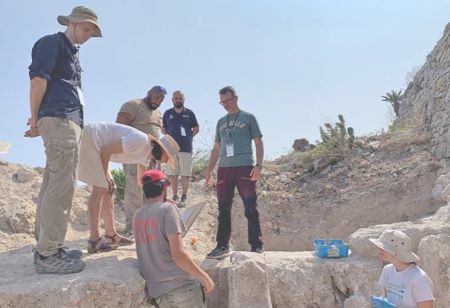You will really fascinated here on Health Orchid blog to learn that a important discovery has been made by a team of researchers and students from the University of South Florida during their excavation in Malta. The findings shed light on the lives of people living in ancient Melite during the time of Roman rule.
USF's official website revealed a tremendous article "Uncovering Ancient History: USF Team Discovers 2,000-Year-Old Roman Home During Excavation in Malta" by author "Cassidy Delmarter".
The Deputy Chief of Mission of the U.S. Embassy in Malta, Angela Cervetti, visited the archaeological excavation site to meet USF students and USF IDEx staff members to learn more about the dig and their role in the international research project. Photo by: Davide Tanasi |
Here are 7 key points:
Discovery of a Well-Preserved Roman House
The researchers and students uncovered a remarkably well-preserved Roman house, known as a Roman Domus, in the ancient city of Melite in Malta. The mansion had been covered by layers of soil for centuries.
Collaborative Effort
Led by Professor Davide Tanasi and USF's Institute for Digital Exploration (IDEx), the team collaborated with scientists from around the world on the Melite Civitas Romana Project. The goal was to learn about life in Malta around 2,000 years ago when the Romans were in control and the island was used for military and trade purposes.
Historical Significance
The Roman Domus, used between the 1st century BCE and 2nd century CE, was lavishly decorated with mosaic floors, wall frescoes, and marble decorations. It was likely inhabited by someone of high status, possibly a representative of the emperor or a wealthy individual connected to the imperial court.
Urban Fabric Understanding
The discovery of an adjacent house with unusually tall walls provided insights into the urban structure of ancient Melite. This information contributes to understanding the human experience and behavior based on the surrounding environment.
Garbage as a Clue
The team found a deposit of discarded items near the newly discovered house. By studying this "garbage," which included fragmented pottery, glass vessels, animal bones, and charcoal, they aim to learn more about the life of the people who lived in the house. Such artifacts can provide valuable insights into daily life and habits.
Digital Preservation
The Institute for Digital Exploration (IDEx) is also involved in the project by preserving cultural heritage through digital methods. They use techniques like digital photogrammetry and terrestrial laser scanning to create 3D models of the site. These digital approaches help document and share the findings with the public.
Future Exploration
The team's permit to continue excavations in the Roman Domus district has been extended until 2025. The next summer's exploration will focus on learning more about the identity of the owner of the newly discovered house.
Overall, this discovery not only provides a glimpse into the lives of ancient Romans in Malta but also highlights the importance of interdisciplinary collaboration and innovative digital techniques in archaeology and cultural preservation.
Source: University of South Florida [JULY 26, 2023]




0 Comments